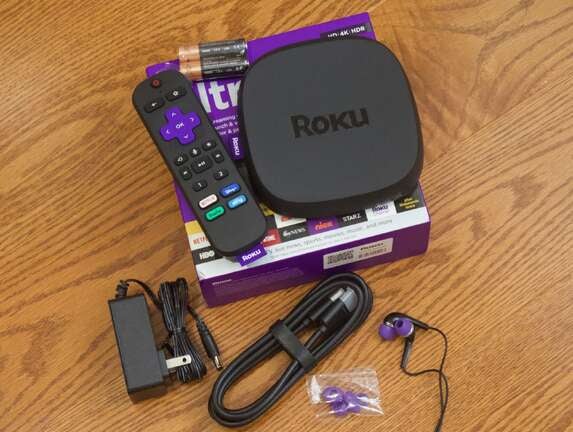
Late last month, Roku announced an all-new Roku Ultra, which—unlike the 2019 model—is full of enhancements.
Most notably, the 2020 Roku Ultra is the first Roku streaming player with built-in Dolby Vision and Dolby Atmos. It also has a better processor, faster memory, and more (and better) on-board storage which Roku says should improve speed by up to 30%.
The device begins shipping today, but we got an early look at the device and these are our thoughts on the 2020 Roku Ultra streaming player.
Roku Ultra (2020)
Roku Ultra (2020) Video Review
What’s New
For the first time since the 2017 Roku Ultra, the device has a slight change to the body. The entire surface of the device is in a matte black, which gives it a smoother look and feel.
Under the hood, Roku says they added a faster quad-core processor, improved memory speed, and more (and faster) storage. They’ve optimized Roku OS to support the new hardware enhancements, which has made this latest Roku Ultra the most performant Roku device ever.
We get into what that means, in terms of real-world usage, a bit later.
With the new hardware enhancements, Roku streamers will be able to stream in Dolby Vision for the first time, and—with a compatible soundbar—with Dolby Atmos audio. The device also supports AV1, which isn’t widely used, but should allow more efficient video processing in the future.
Roku has also added Bluetooth to the Roku Ultra for the first time and improved wireless range by 50%.
Gone is the microSD card slot, which has been replaced by a USB 3 (Type-A) port. Previously, the microSD card slot could be used for app caching; this has now moved to the internal storage. The USB 3 port can be used for your personal media library of movies, audio, and photos—but not for additional external storage.
What’s In The Box
Roku Ultra (2020)
When you first open the box, you’ll see the Roku Ultra which, like previous generations, is about the size of a small portable hard drive. The single, smooth matte-black finish around the device, blends in nicely with most A/V hardware that you likely have in your console.

Underneath the device, you’ll find a user guide, as well as the enhanced voice remote (including batteries) which, like the 2019 model, comes with two customizable buttons.
Also included are a power adapter and earbuds (now with purple tips), which Roku started bundling with the 2018 edition of the Ultra. They are nice to use for private listening via the built-in headphone jack on the remote.
For the first time, this Roku comes with a premium HDMI cable, which was a surprisingly nice addition. I remember last year, when I was reviewing a device, scrambling to find an HDMI cable (and ended up taking one from another device).

Just like previous models of the Roku Ultra — the 2020 Roku Ultra includes a built-in an 10/100 Ethernet port and 802.11ac MIMO dual-band wireless. But for the 2020 model, Roku says that the wireless range has been improved by 50%.
Roku Ultra (2020)
Remote
There were no major changes with the 2020 Roku Ultra remote, with the exception of the streaming services promoted on it.
This year’s model (which sometimes can differ based on where you buy it) has Hulu, Disney+, Sling TV, and Netflix.
The Roku Ultra remote is noticeably heavier and thicker than other Roku remotes, like the Roku Streaming Stick+.
That’s because, like with other Roku Ultra devices’ remotes, the left side of this remote has a headphone jack, which lets you enable private listening. This is an especially great feature for those who want to watch TV, but share a room with someone on a different sleep schedule.
The Enhanced Voice Remote keeps the same customizable buttons that first appeared in the 2019 model. But, unfortunately, they haven’t improved on the experience from last year.
The customizable buttons must be programmed by voice, meaning that anything you can do with a single-command by voice can be assigned to a button. To program it, you press and say a voice command such as “Launch YouTube TV”, then hold down one of the customizable buttons for 2 seconds. You will hear a quick beep and then your last voice command gets assigned to the button.
Roku has a long list of voice search options including launching channels, browsing genres, specific shows, playing music channels, or controlling playback.
Some users might use it to play their favorite playlist on a music service like Pandora—for example, “play Taylor Swift radio.” Others might add an additional Playback command like “skip 1 minute,” which won’t work across all channels, but will on some like The Roku Channel.
Since the buttons don’t have any indicator on them, you’ll have to remember the shortcuts assigned to each button. As an improvement, it would have been nice to be able to program the buttons to control your TV, to do things like change input (which doesn’t exist on the remote).
I do wish that it wasn’t tied to voice commands, because it more or less is just launching a voice command when you click. It’s noticeable slower when you use shortcut button to open a streaming app like Netflix. Also, when you’re in another app, it makes you confirm that you actually want to leave the current app, which doesn’t happen with the built-in streaming app buttons.
I’m going to say this every year—in a hope to will-it into existence: I would love to see in a future edition that has backlit buttons. It would be the great enhancement, similar to private listening, that would improve the experience late at night.
Overall, Roku continues to have my favorite remote of all the streaming devices. So, if you liked the remote before, it’s just as good as before.
Roku Ultra (2020)
Set-Up
Roku continues to nail the set-up experience for users. After connecting to Wi-Fi, they ask for your e-mail address to continue to set-up on your phone.

If you are an existing Roku user, you can just log-in and it will automatically install the apps you have on your other Roku devices.
One incredibly nice feature is: for many apps, if you are already signed-in on another device, you will be automatically signed-in on your new Roku Ultra. This will save you about a half hour of trying to type your email and password into each streaming app.
Performance
The other major feature that Roku touted in the 2020 Roku Ultra is up to 30% faster boot times, channel launching, and video starts.
The internals of Roku Ultra devices since 2017 included an ARM Cortex A53, but this 2020 model adds an ARM Cortex A55. It also has 2GB of memory, which is twice that of the Roku Ultra LT and the 2017/2018 Roku Ultra (the 2019 Ultra also had 2GB).
There is more internal storage and its faster, but Roku wouldn’t confirm the exact amount. Last year’s model had 512 MB. Given that their is no microSD slot, the device now relies purely on internal storage for channel apps.
Last year’s model was supposedly 20% faster (all through app caching) but, to be honest, in our testing it wasn’t very different, so with the hardware improvements, we wanted to see how fast the 2020 model would be.
Out of the gate, you’ll notice that the interface is noticeably snappier. When navigating with the remote, it doesn’t lag at all. When it comes to channel launching, the performance gains will depend on the app.
To test the device, we launched and streamed three different streaming services to measure launch time and time to first video load, which Roku said were some of the areas where you would see the biggest speed improvement.
In our tests, Netflix launched about 15% faster (~3 vs. 3.5 seconds) than the 2019 model. fuboTV saw the biggest improvement: about 30% faster (~8.5 vs. 11 seconds). Sling TV more or less saw the same at ~6.5 seconds to first launch.
When launching a video or switching between a live channel, the three services had very different (but not necessarily better) results.
fuboTV loaded video about 40% faster than on the 2019 model, while Sling TV saw video load times that were 15% slower (which only amounts to about a half second). Netflix video launch times were about 0.25 seconds faster (~5%) than on the 2019 model.
These tests are far from perfect, but are meant to capture some of the real world improvements you might see with the device.
For most apps, unless you were comparing them side-by-side, you probably wouldn’t notice that they are launching faster. But, when it comes to navigating the interface, I think you will appreciate the improvements.
Audio & Video
4K Streaming
The device supports 4K HDR streaming, including HDR10, and for the first time: Dolby Vision. Over the past year there have become more streaming apps to support Dolby Vision, including Disney+, Apple TV+, and Netflix.
On nice addition in Roku OS 9.4 is the ability use AirPlay 2 (and HomeKit). This opens up the ability to stream apps like HBO Max and Twitch, which don’t have native Roku channels.
Audio
The device supports audio via Dolby Digital and Dolby Atmos, if you have a supported soundbar. It also supports Dolby Atmos pass-through over HDMI.
This is also the first Roku streaming player with built-in Bluetooth. It was a nice enhancement if you stream music on your TV. It’s simple to connect on your phone and then you can either use your Roku remote or your phone to control the experience on the TV.
Roku Ultra (2020)
Should You Buy It?
The 2020 Roku Ultra ($99) is the top-of-the-line Roku device. Previously, the reason to buy it over the lower priced Roku Streaming Stick+ is for the built-in Ethernet port and USB port for local video playback.
With the additions in the 2020 Roku Ultra, you can add support for Dolby Vision, Dolby Atmos, better Wi-Fi range, and actually better hardware. The Streaming Stick+ has a slower processor and half the internal memory.
We would definitely recommend the 2020 Roku Ultra for someone who wants to ensure consistent live streaming performance.
The Roku Ultra has a built-in 10/100 Ethernet port; while it does not have Gigabit Ethernet, the ability to hardwire to your router will give it a leg up to other Roku models. But if you are going to use Wi-Fi, you will now have a better experience even if its far way from router.
Unlike last year’s model, I think you can make a case for upgrading from the 2017, 2018, or 2019 Roku Ultra. The changes in past years have mostly been secondary, while the 2020 Roku Ultra has major enhancements under-the-hood. If you want Dolby Vision or Dolby Atmos support, getting the 2020 model is a no-brainer.
Are the speed improvements from the 2019 Roku Ultra night-and-day? No. But, I will say that when it comes to the interface, its snappier than on any Roku device I’ve used.
So if you’re in the market for a Roku device, the all-new Roku Ultra checks nearly all the boxes that we’d expect from a high-end streaming device.








